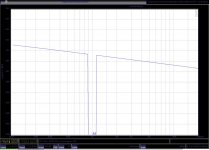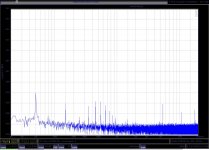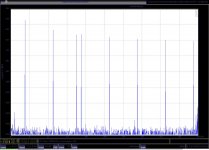George, with loudspeakers that is another story. I use the Klippel and Praxis since they came out. I can show you that a very well designed speaker has distortion under the audible threshold. Bill Waslo and i designed a distortion isolation test that put the original signal in one ear with headphones and the distortion residuum in the other. With well designed speakers i could hear NOTHING in the distortion channel because of masking.
Switching out the music on the undistorted channel i could hear something. Audio magazine even put out a CD with my measurements. An altogether harder problem is dynamic range and bandwidth, in speaker that is. Using the Klippel i got that distortion down by 10dB the last 10 years.
Switching out the music on the undistorted channel i could hear something. Audio magazine even put out a CD with my measurements. An altogether harder problem is dynamic range and bandwidth, in speaker that is. Using the Klippel i got that distortion down by 10dB the last 10 years.
In the context of designing an opamp circuit -- which tests will best seperate them and determine weaknesses and in the end, which design is the better one? Or which combinations of tests will determine which is the better circuit? This knowledge can drive the design. Thx - RNm
Here are the dynamic measurements i did on an INA i constructed with 2 AD797 and 1 LT1648 for MC cartridge head amp purpose.
Watch the scale, the resolution limit is at -150dB. This is done by gain ranging two 24Bit AD/DA converters. The measurement are pretty astounding and the sound i got was very good. I can do better though subjectively with designs that measure still very good but not as well.
Watch the scale, the resolution limit is at -150dB. This is done by gain ranging two 24Bit AD/DA converters. The measurement are pretty astounding and the sound i got was very good. I can do better though subjectively with designs that measure still very good but not as well.
Attachments
My personal feeling is that it will be the one that has the best rejection of noise and interference by the very nature of the topology. Obviously PSRR is a prime culprit to be investigated, but what about throughout the rest of the circuit: if the circuit is poorly executed by a DIY'er and can easily pick up stray signals, couple with extraneous influences, then how many weak spots in this, theoretical design, sense, occur through the circuit at the various junctions of the parts?In the context of designing an opamp circuit -- which tests will best seperate them and determine weaknesses and in the end, which design is the better one? Or which combinations of tests will determine which is the better circuit? This knowledge can drive the design. Thx - RNm
Frank
Here is one more. I even called it "Gold standard" because it measured so well.
Hi Joachim
What does this measurement show?
And I wasn't meaning loudspeaker testing. 🙂
Thanks for the link Distortion Isolation in the Time Domain
Regards
George
very nice results --- Do you have data on other speakers/drivers that are as good? Such as, one of my favorites I drag out every so often -- The New Quad electrostatic speakers? I understand they re very low distortion full range speakers. My reference speakers for very low distortion and very flat response.Here is the distortion measured at 1 Pascal on the midrange of my private speaker.
Between 200Hz and 5KHz it is under 0.1%, better then many tube amps.
My personal feeling is that it will be the one that has the best rejection of noise and interference by the very nature of the topology. Obviously PSRR is a prime culprit to be investigated, but what about throughout the rest of the circuit: if the circuit is poorly executed by a DIY'er and can easily pick up stray signals, couple with extraneous influences, then how many weak spots in this, theoretical design, sense, occur through the circuit at the various junctions of the parts?
Frank
Got to keep loop areas small, and use FETs where possible due to their appreciably lower propensity to rectify RF. Run lots of current to make the signals liable to contamination proportionally larger. Go balanced wherever possible, even internally. These are all things available to us that are constrained by comparison in ICs.
Many years ago Walt Jung was giving a talk about opamps and their ability to self-rectify RF. As a question/comment from the floor, I suggested that, due to their purportedly good matching in a dual, that one opamp might be used as the RF detector and its output deployed to subtract the detected envelope from the actual signal-processing one. Walt thought it a good idea. I'm not sure if anyone ever tried it.
Nowadays the interfering frequencies are so high, such as from cellphones, that the scheme would likely be impractical. And there are other ways.
Harmonics will not be seen. The idea is that noise will increase. But how this
noise will be measured in the presense of such a big population of main tones?
But new relevant methods are already proposed 😉 :
http://www.listeninc.com/PDFs/paper_121AES_non_coherent_distortion_Listen_Inc.pdf
George
This is good.... I had suggested broadband random noise generator in place of music. [ Since I have one in stock.]
I'll download that paper and reread it. Thx
Last edited:
George, the measurements are explained in post 1099. From left to right, top to bottom :
Noise test, Belcher Test, Sine-square superposition.
No, i do not know any dynamic speaker that has such low distortion at such high volume.
Yes, the Quads have very low distortion but mecahnics are a crook and they do not play much louder then 100dB. When you strip them and make a really rigid frame they are cool up to a certain volume. You will be also be surprised about the compromised parts they use. For example there is an input cap before the transformer that has to substituted, and then the terible clamp overload supression. Nevertheless a stroke of genius.
Horn speakers can have low third but they still have high second.
Noise test, Belcher Test, Sine-square superposition.
No, i do not know any dynamic speaker that has such low distortion at such high volume.
Yes, the Quads have very low distortion but mecahnics are a crook and they do not play much louder then 100dB. When you strip them and make a really rigid frame they are cool up to a certain volume. You will be also be surprised about the compromised parts they use. For example there is an input cap before the transformer that has to substituted, and then the terible clamp overload supression. Nevertheless a stroke of genius.
Horn speakers can have low third but they still have high second.
Last edited:
A good appl for DADiSP software.This is good.... I had suggested broadband random noise generator in place of music. [ Since I have one in stock.]
I'll download that paper and reread it. Thx
Here is an astounding claim from National Semi. I would call that settling time. What happens after an aprupt transient ? How long does the opamp need to pull the output to zero ?
And you thought that kind of advertizing was only done in high end audio 🙂
Yes, the Quads have very low distortion but mecahnics are a crook and they do not play much louder then 100dB. When you strip them and make a really rigid frame they are cool up to a certain volume. You will be also be surprised about the compromised parts they use. For example there is an input cap before the transformer that has to substituted, and then the terible clamp overload supression. Nevertheless a stroke of genius.
QUOTE]
I use a pair of TC Sounds LMS Ultra 5400 18 inch and 4 each Cerwin Vega 15 inch to take care of the bottom... then the Quads (modified). Super low distortion and high spl where it is needed. You can really hear what equipment sounds like - the good, bad and the ugly. -RNM
One that shapes up nicely, optimised dynamic design is: NRC Measurements: Vivid Audio Giya G2 Loudspeakersvery nice results --- Do you have data on other speakers/drivers that are as good? Such as, one of my favorites I drag out every so often -- The New Quad electrostatic speakers? I understand they re very low distortion full range speakers. My reference speakers for very low distortion and very flat response.
This has also received excellent subjective reviews ...
Now, if only one can get to like the look of it ... 🙂
Frank
Last edited:
Here is an astounding claim from National Semi. I would call that settling time. What happens after an aprupt transient ? How long does the opamp need to pull the output to zero ?
Sigh. It seems each generation must learn anew.
Why not try a variation of this circuit as well, Richard? A few resistor changes, and it should be OK.
Ok. Do you have any measured data on it?
Last edited:
- Home
- Source & Line
- Analog Line Level
- Discrete Opamp Open Design




